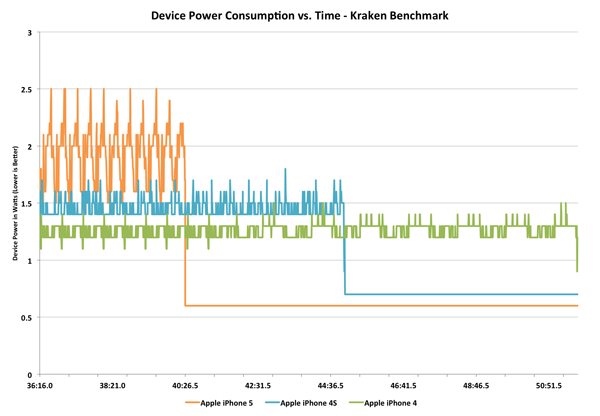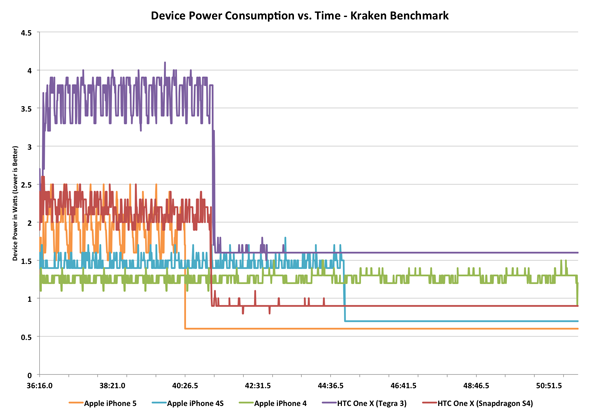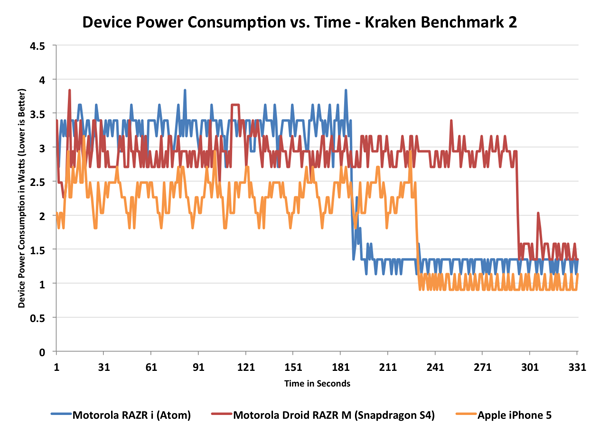The iPhone 5 Review
by Anand Lal Shimpi, Brian Klug & Vivek Gowri on October 16, 2012 11:33 AM EST- Posted in
- Smartphones
- Apple
- Mobile
- iPhone 5
Increased Dynamic Range: Understanding the Power Profile of Modern SoCs
Section by Anand Shimpi
The iPhone 4S greatly complicated the matter of smartphone power consumption. With the A5 SoC Apple introduced a much wider dynamic range of power consumption to the iPhone than we were previously used to. Depending on the workload, the A5 SoC could either use much more power than its predecessor or enjoy decreased overall energy usage. I began our battery life analysis last time with some graphs showing the power savings realized by a more power hungry, faster CPU.
The iPhone 5 doesn't simplify things any more. I believe the days of us having straightforward discussions about better/worse battery life are long gone. We are now firmly in the era of expanded dynamic range when it comes to smartphone power consumption. What do I mean by that? The best way to explain is to look at some data. The graphs below show total device power consumption over time for a handful of devices running the Mozilla Kraken javascript benchmark. Kraken is multithreaded and hits the CPU cores fairly well. The power profile of the benchmark ends up being very similar to loading a very js-heavy web page, although for a longer period of time. All of the device displays were calibrated to 200 nits, although obviously larger displays can consume more power.
Let's start out by just looking at the three most recent iPhone generations:
The timescale for this chart is just how long the iPhone 4 takes to complete the Kraken benchmark. The iPhone 4/4S performance gap feels a lot bigger now going back to the 4 than it did when the 4S launched, but that's how it usually seems to work. Note how tight the swings are between min and max power consumption on the iPhone 4 during the test. As a standalone device you might view the iPhone 4 as being fairly variable when it comes to power consumption but compared to the 4S and 5 it might as well be a straight line.
The 4S complicated things by consuming tangibly more power under load than the 4, but being fast enough to complete tasks in appreciably less time. In the case of this Kraken run, the 4S consumes more power than the 4, however it's able to go to sleep quicker than the 4 and thus draw less power. If we extended the timeline for the iPhone 4 significantly beyond the end of its benchmark run we'd see the 4S eventually come out ahead in battery life as it was able to race to sleep quicker. The reality is that with more performance comes increased device usage - in other words, it's highly unlikely that with a 50% gain in performance users are simply going to continue to use their smartphone the same way as they would a slower device. Usage (and thus workload) doesn't remain constant, it's somewhat related to response time.
The iPhone 5 brings new meaning to device level power consumption. With a larger display and much more powerful CPU, it can easily draw 33% more power than the 4S under load, on average. Note the big swings in power consumption during the test. The A6 SoC appears to be more aggressive in transitioning down to idle states than any previous Apple SoC, which makes sense given how much higher its peak power consumption can be. Looking at total energy consumed however, the iPhone 5 clearly has the ability to be more power efficient on battery. The 5 drops down to iPhone 4 levels of idle power consumption in roughly half the time of the iPhone 4S. Given the same workload that doesn't run indefinitely (or nearly indefinitely), the iPhone 5 will outlast the iPhone 4S on a single charge. Keep the device pegged however and it will die quicker.
Out of curiosity I wanted to toss in a couple of other devices based on NVIDIA and Qualcomm silicon to see how things change. I grabbed both versions of the HTC One X:
The Tegra 3 based One X actually performs very well in this test, but its peak power consumption is significantly worse than everything else. It makes sense given the many ARM Cortex A9 cores built on a 40nm G process running at high clock speeds on the Tegra 3.
The 28nm Snapdragon S4 (dual-core Krait) based One X gives us some very interesting results. Peak power consumption looks identical to the iPhone 5, however Apple is able to go into deeper sleep states than HTC can with its S4 platform. Performance is a little worse here but that could be a combination of SoC and software/browser. I used Chrome for all of the tests so it should be putting Android's best foot forward, but the latest update to Safari in iOS 6 really did boost javascript performance to almost untouchable levels.
At the end of the day, the power profile of the iPhone 5 appears to be very close to that of a modern Snapdragon S4 based Android smartphone. Any battery life gains that Apple sees are strictly as a result of software optimizations that lead to better performance or the ability to push aggressively to lower idle power states (or both). It shouldn't be very surprising that these sound like a lot of the same advantages Apple has when talking about Mac battery life as well. Don't let the CPU cores go to sleep and Apple behaves similarly to other device vendors, but it's really in idle time or periods of lighter usage that Apple is able to make up a lot of ground.
There's one member of the modern mobile SoC market that we haven't looked at thus far: Intel's Medfield. The data below isn't directly comparable to the data above, my measurement methods were a little different but the idea is similar - we're looking at device level power consumption over time while Kraken runs. Here I'm only focusing on the latest and greatest, the Atom based Motorola RAZR i, the Snapdragon S4 based Droid RAZR M and the iPhone 5. The RAZR i/M are nearly identical devices making this the perfect power profile comparison of Atom vs. Snapdragon S4. The RAZR i is also the first Atom Z2460 based part to turbo up to 2.0GHz.
Very interesting. Atom is the only CPU that can complete the Kraken benchmark in less time than Apple's Swift. Peak power consumption is definitely higher than both the Qualcomm and Apple devices, although Intel's philosophy is likely that the added power usage is worth it given the quicker transition to idle. Note that Atom is able to drive to a slightly lower idle level than the Snapdragon S4, although the Swift based iPhone 5 can still go lower.
At least based on this data, it looks like Intel is the closest to offering a real competitor to Apple's own platform from a power efficiency standpoint. We're a couple quarters away from seeing the next generation of mobile SoCs so anything can happen next round, but I can't stress enough that the x86 power myth has been busted at this point.
I will add that despite Intel's performance advantage here, I'm not sure it justifies the additional peak power consumption. The RAZR i ends up being faster than the iPhone 5 but it draws substantially more power in doing so, and the time savings may not necessarily offset that. We'll see what happens when we get to our battery life tests.













276 Comments
View All Comments
A5 - Tuesday, October 16, 2012 - link
I don't think there's a good way to measure storage performance on the iPhone. Also not really sure why it matters.repoman27 - Tuesday, October 16, 2012 - link
I timed how long it took to transfer my music library, and clocked 11.1 MB/s writing to the user area of a 64GB model. So no significant change from previous iPhones, and still pretty typical for a smartphone. I'd be interested to get some gauge of the read speeds.And @A5, storage performance affects boot and application load times as well as sync and backup. With a 64GB model, syncing can take quite a while.
name99 - Wednesday, October 17, 2012 - link
Transferring the music library is a LOUSY choice for speed measurement because (depending on your iTunes settings) you may be transcoding all your music to a lower bit rate to fit more on the iPhone; so you are gated by the transcoding performance, not the flash write speeds. I transcode my music (most in Apple lossless on my iMac) to 192kbps AAC for my iDevices, and on my ancient iMac it is the transcoding that throttles performance.A much better situation to look at is transferring large movies. On my devices
- iPhone 4 writes at about 18MB/s
- iPad3 writes at about 22MB/s
Over the last 6 months Anand occasionally has published flash numbers for Android phones and they're generally around half these Apple numbers.
repoman27 - Wednesday, October 17, 2012 - link
Believe you me, I don't allow iTunes to transcode anything, except to ALAC on occasion. But yes, that number I gave was on the low side, but probably more due to it being thousands of files as opposed to one large sequential write.I just transferred a large video file back and forth directly to and from the user storage area of one of my apps, and came up with numbers that are more in line with yours. 23.84 MB/s avg read and 20.05 avg write.
Most MLC NAND modules capable of 20 MB/s writes should be able to do at least 40 MB/s on sequential reads, which leads me to believe that we're still gated to around 25 MB/s by the NAND interface here, which is kinda bogus.
Spunjji - Friday, October 19, 2012 - link
name99, that is not a "better situation" because the performance figures you quote only apply to large block file transfers. It's no more real-world than the figures repoman quoted, which are not "LOUSY". Both are valid, so ideally a proper test should mix both types of data.Furthermore, the idea that your admittedly ancient iMac being crap at transcoding MP3s somehow invalidates somebody else's testing is ridiculous as well. With any decent system that would only be the case if you were shifting data to a device a *lot* faster than any smartphone NAND.
So, you may need to rethink your "victory" a little more.
KPOM - Wednesday, October 17, 2012 - link
I've had my iPhone since 9/22 and there is not a single scuff on it. My guess is that in the rush, some units got through QC, but the phone itself isn't any more prone to scratching in normal use than other phones. Meanwhile, Apple being Apple, they have held up production to improve QC even if it means fewer sales in the short run.rarson - Wednesday, October 17, 2012 - link
You've had it less than a month. There shouldn't be any scuffs on it."Apple being Apple"
Ha! That's a good one!
Spunjji - Friday, October 19, 2012 - link
Trololololol"Mine is fine so everyone else is lying". <- Possibly my favourite bogus argument ever. Apple the generous indeed...
doobydoo - Saturday, October 20, 2012 - link
Because it's so much more compelling than the 'Mine is scratched so everyone elses must be'?lukarak - Wednesday, October 17, 2012 - link
But it doesn't rust. It scratches if it comes in contact with something harder. Just as a car does. Would you buy a car that gets a scratched bumper when you hit a wall? Well, maybe you wouldn't but people do. Regularly.This iPhone is no different than every other iPad, MBP or MBA or the first Al MB. Or any other device constructed from aluminium. They scratch if they are brushed against something. It's just normal.